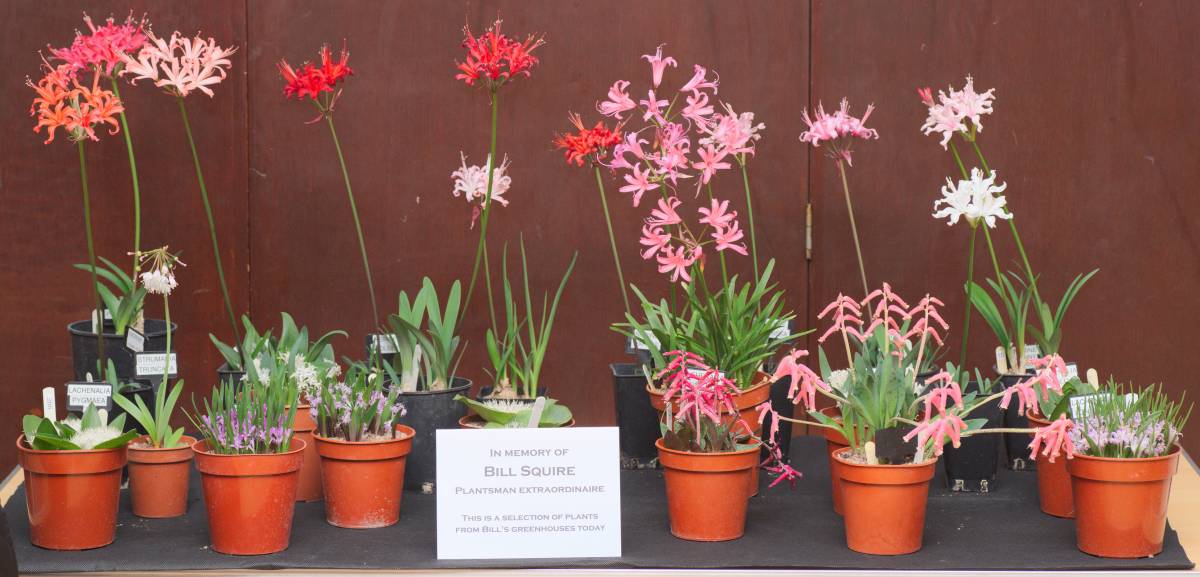Display of Bill Squire's plants
[Click on the image for a larger version, which may be slow to appear, but can be enlarged further]
This display of just a few of Bill Squire’s plants was presented by Tony Bennett with the assistance of Leo Squire at the meeting of the Dorset Group of the Alpine Garden Society on the 1st November, 2018. A small but appropriate tribute to a wonderful man. Bill was well known as the former Chairman of the Dorset Group and long-standing Show Secretary for the Alpine Garden Society Wimborne Show, until very recently Chairman of the Southern African Bulb Group, and an active member of the Nerine and Amaryllid Society and the Scottish Rock Garden Club.
In the back one or two rows of the display are a dozen Nerines (all but one in black pots) with tall inflorescences topped with large flowers in shades of white, pink, red and orange. These are hybrids of Nerine sarniensis which need to be grown under glass, not the hardy N. bowdenii. The ones whose labels can be read (or guessed, hopefully correctly) in the photo include, from left to right, the orange “Itchen Stoke”, the pinkish-red “Plymouth”, “Wolsey” (red), two whose partly obscured names appear to be “Daphne” (orange-red) and “Clarissa” (pink), and finally “Jenny Wren” with two spikes of pale pink flowers at the far right.
Just in front of the two Nerines at the far left, in a terracotta-coloured plastic pot like all the following plants, is Strumaria truncata. Like Nerine, it is in the Amaryllid family. This species has flowers which hang downwards, unlike other Strumarias which usually have small delicate star-shaped flowers on long pedicels facing upwards. All the other plants in the display are in the Hyacinth family, including Lachenalia and close relatives.
Bill is particularly known for his Lachenalias, and he was the custodian of the National Collection of Lachenalia, approved by the National Council for the Conservation of Plants and Gardens. It is too early for most true Lachenalias to be in flower, but a couple of early ones can be seen in the photo at the front, to the right of the sign: Lachenalia punctata with spotted red flowers (formerly known as L. rubida) and, to the right of it, L. bulbifera with plain pink flowers. L. bulbifera is a common plant that many of us grow.
The genus Lachenalia has recently been expanded to include Polyxena, which have much shorter flowering spikes, often hidden among the leaves, and small flowers which often open wider into little stars. Because they flower earlier than the typical Lachenalias, there are several in the display. Three are pink-flowered: one is just to the left of the notice and to the left of that one there is Lachenalia paucifolia; at the extreme right in the front row is L. longituba. Four are white flowered, two on the left: Lachenalia pygmaea on the far left at the front, another behind the pink L. paucifolia, and two on the right: L. ensifolia behind the L. bulbifera, and L. calcicola behind the pink L. longituba.
Finally there is a very short white-flowered, broad-leaved plant immediately behind the notice, whose name label is not visible. (I should have made notes!) It looks like a Massonia, but it might possibly be a Lachenalia of the Polyxena type, and appears to resemble the plant labelled Lachenalia pygmaea on the far left. (Please let me know if you can clarify this or any other identification.) All three genera (and Daubenya) are closely related and subject to much taxonomic uncertainty. All the plants shown are of course winter growers which need protection from frost in the UK, and will die back in the spring and remain dormant during the summer.
Richard White, 2 November 2018
